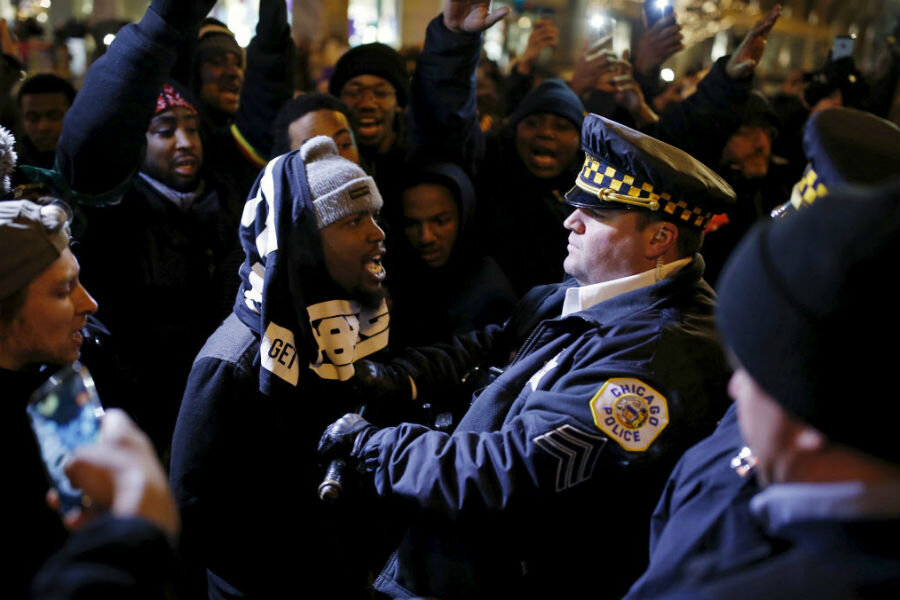Chicago PD begins de-escalation training: Can it curb police shootings?
Loading...
The Chicago Police Department became the latest last week to introduce new training methods, with a heightened focus on de-escalating interactions that could otherwise turn violent.
As a national focus on policing techniques intensifies in the wake of a series of highly publicized officer-involved shootings, a number of police departments, like Chicago, are beginning to rethink and remodel their training techniques. Los Angeles, Seattle, Las Vegas, and others have adjusted their training models to emphasize de-escalation tactics in an effort to reduce the number of incidents involving force.
But determining how and when officers should rely on de-escalation strategies – talking a citizen into putting down a weapon rather than shooting him or her, for example – is tricky, and those working in the field frequently disagree on the extent to which such tactics should be used, and the extent to which such tactics are effective.
As one of the first to shift training tactics to emphasize de-escalation, the Dallas Police Department saw a dramatic decrease in arrests, excessive force complaints, and officer-involved shootings between 2009 and 2015. Some experts praised Dallas for its new training techniques, urging other departments to follow suit.
"We can learn from what Dallas is doing," Chuck Wexler, executive director of the Police Executive Research Forum in Washington, D.C., told the Dallas Morning News. "That’s what police departments need – they don’t need training in silos: one day about the law, one day about firearms, one day about crisis intervention."
Others cautioned against assuming a causation effect between the shift in training and the lower number of incidents, as a number of other factors could have also played a role. But as Alex Piquero, a criminal justice professor at the University of Texas at Dallas, pointed out to the Dallas Morning News, the trend "continues to go in the same direction for a sustained period of time," suggesting that the department's reality-based training, which simulated real-life scenarios recorded by dash and body cameras, did have something to do with the decline.
Those who are hesitant to fully embrace the tactics taught through de-escalation training often express concerns that the techniques, particularly the emphasis on talking before taking action, may not do enough to protect officers in dangerous situations.
"The concern we have is that hesitation might end up having an officer getting killed or assaulted," said Harvey Hedden, executive director of the International Law Enforcement Educators and Trainers Association, to The New York Times. "Sometimes using the least amount of force turns out to be a bad idea. It's a myth that officers want to use more force."
The risks increase when dealing with civilians who are used to fighting force with force in confrontations with officers, and are more likely to become aggressive at an earlier point in the interaction.
"We've always been supposed to help people, but the emphasis has gone way farther the other way," said J Moyer, a 28-year veteran of the Seattle police department, to the Times. "The emphasis now is that we're supposed to be social services, whereas it had been our job to look for bad guys. We're not supposed to offend anybody, but the bad guys aren't playing by the same rules."
The Chicago Police Department, like other departments shifting their training tactics to focus on de-escalation, will now be faced with the challenge of encouraging its officers to take a slower, gentler approach while still stressing that force is, at times, necessary.
"When we can reduce the risk of taking a life even if it's a bad guy, we should. ... We should not use force simply because we can," Sgt. Larry Snelling, the lead instructor for the Chicago department's de-escalation training, told the group at the start of training, The Chicago Tribune reports. "But when you are faced with an immediate threat and your life or someone else's life is on the line … you should respond with deadly force. You have to."
While the changes have transformed the way the department will be trained, for some Chicago officers, a priority on de-escalation is nothing new. Officer Marianne Horan Dawson, an 18-year veteran with the department, told trainees last week that she has been unofficially using similar tactics for years.
"The best way (to learn) is to be on that street and learn how to handle people," said Officer Dawson. "First of all, you have to quiet them. You let one speak, and you let the other speak. You won't fix peoples' broken lives, but we can try to fix it for that night."








